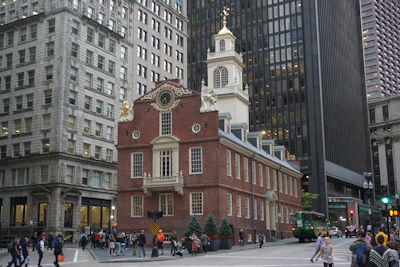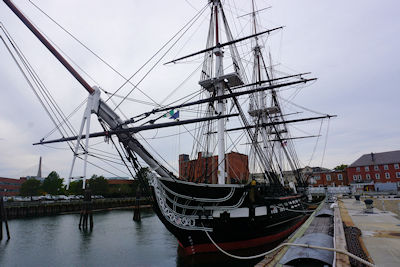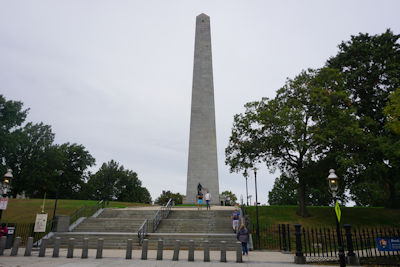
The American Revolution was a fight for freedom and liberty that not only gave birth to the United States but helped spread the concept of democracy as well. A litany of indelible moments led to its success – from a brutal winter at Valley Forge to a final siege at Yorktown – testaments to the American spirit and the principles upon which the nation was founded. Although the War for Independence spread across all thirteen colonies, however, there was one city in particular that was pivotal in the initial rebellion.
That city was Boston, Massachusetts, home of Samuel Adams, John Hancock, and Paul Revere, as well as tea parties and shots heard round the world. The Declaration of Independence may have been signed in Philadelphia and a Virginian chosen as general of the Continental Army, but it was Boston that ignited a revolution.
A visit to Boston is thus a journey through history itself, with many of the landmarks that gave rise to the American Revolution located on a 2.5-mile stretch known as the Freedom Trail. Beginning at Boston Common and winding its way past the site of the Boston Massacre, the burial grounds of Samuel Adams and Paul Revere, the Old North Church and all the way to Bunker Hill, the Freedom Trail is where the seeds of liberty were initially planted.
The roots of the American Revolution can be traced to the Stamp Act of 1765. After the French and Indian War, Great Britain was saddled with a large debt that the British Parliament believed the colonists should pay. Virginia was the first to balk at such a proposal, but it was Boston’s reaction that was the most vehement, leading to Samuel Adams forming the Sons of Liberty and giving rise to the phrase “No taxation without representation.”
The Stamp Act was quickly repealed but later replaced by the Townshend Acts in 1767. Civic unrest continued to grow in Boston, meanwhile, resulting in British troops stationed in the city to enforce the laws of Parliament. On March 5, 1770, tensions between the colonists and the soldiers reached a boiling point, resulting in a mob of Bostonians confronting a British sentry. As the taunting continued, additional British soldiers arrived on the scene. The situation then quickly deteriorated until the six soldiers fired into the crowd, instantly killing three Americans with two more dying afterwards.
The site of the Boston Massacre was underneath the balcony of what is today known as the Old State House, one of the many stops on the Freedom Trail. A cobblestone circle marks the spot while a grave marker in the Granary Burying Ground – another destination on the Freedom Trail – honors the memory of those who died there.
While the Boston Massacre continued to sow the seeds of discontent within the colonies, another historic event soon erupted as well. In 1773, the East India Company was in the midst of severe financial troubles and had a large surplus of tea that it needed to unload. Selling it to America was the logical solution, but the British Parliament insisted that the tea – which was to be sold at a drastically reduced price – should likewise be taxed.
The colonies resisted the tax even though the price of the East India Company tea was still cheaper than regular tea. Protests raged in New York, Philadelphia, and Charleston, but it was again the actions of Boston colonials that fanned the flames of revolution. Three ships arrived in Boston Harbor containing the tea and, by law, they had to unload their cargo within twenty days or else custom officials would seize and unload it themselves. Bostonians, however, didn’t want it.
Massachusetts Governor Thomas Hutchinson was petitioned to have the law waved, allowing the three ships to leave Boston Harbor with the tea still onboard. Close to 5,000 Boston residents met at the Old South Meeting Hall on December 16, 1773, to await word of Hutchinson’s decision. When it was announced that the governor had denied the request, a large group of colonials – dressed as Mohawk warriors – made their way to Griffin’s Wharf, boarded the three ships and dumped the tea into the harbor.
The Old South Meeting Hall that served as the launching point for the Boston Tea Party still stands and is likewise part of the Freedom Trail. The Boston Tea Party Ships & Museum, meanwhile, sits on Boston Harbor near where Griffin’s Wharf was originally located. Visitors to the museum can take part in a re-enactment of events, with a facsimile of the Meeting Hall – replete with an appearance by Samuel Adams – and two replica ships from which fake crates of tea can be tossed into the harbor.
The Boston Tea Party Ships & Museum also contains two relics – a small vial of tea and the sole remaining crate from the Boston Tea Party. The exact origin of the vial is unknown, with one story claiming that a clergyman gathered tea that was washed ashore and then bottled it, while a second states that the tea was from leaves shaken out of the boot of a Tea Party participant.
The crate, meanwhile, was discovered washed ashore the day after the Boston Tea Party by John Robinson, who took it home and hid it until the end of the American Revolution. The crate was subsequently passed down from generation to generation, each of which left their own mark on the crate, from using it as a dollhouse to the home for a litter of kittens. The vial of tea and the crate are the lone remaining artifacts from the Boston Tea Party – an event that directly led to revolution a year later.
It was because of the Boston Tea Party that the British Parliament passed the Intolerable Acts, which closed the port of Boston, limited town meetings in Massachusetts, allowed trials of colonists to be moved to Great Britain, and demanded that Boston residents pay for the lodging of British troops. Meant to deter further protests, the Intolerable Acts had the opposite effect, resulting in the stockpiling of ammunition in the nearby town of Concord.
Boston was a small city at the time, and despite General Thomas Gage’s attempt to keep his plans to destroy the stash of weapons a secret, troop movements within Boston made it obvious that such a mission was underway. On the night of April 18, 1775, Paul Revere was tasked with riding to both Lexington and Concord to warn of the British plan.
Revere’s subsequent journey was immortalized in the poem by Henry Wadsworth Longfellow entitled “Paul Revere’s Ride.” Although historically inaccurate in some parts, lanterns were indeed used at the Old North Church – “one if by land, two if by sea” – as the poem relates. The Old North Church is likewise part of the Freedom Trail, not far from Paul Revere’s house and a statue of Revere riding his horse on the night of April 18, 1775.
The last stop on the Freedom Trail is Bunker Hill. Following the events of Lexington and Concord – which basically resulted in a state of war existing between the Americans and British – a colonial militia laid siege on Boston. In June 1775, the British decided to disburse them by sending troops through Charleston and then into Cambridge. The colonials became aware of the British intentions and sent William Prescott to fortify Bunker Hill in Charleston.
Prescott instead focused on nearby Breed’s Hill, which he occupied during the early hours of June 17, 1775. When the British noticed the colonials’ presence on Breed’s Hill, they mounted an attack later that afternoon. Although the British ultimately prevailed, it was a costly victory, with over half of their 2,000 soldiers either killed or wounded. The Battle of Bunker Hill – despite being incorrectly named – thus proved that Americans were both willing and able to sustain a revolutionary war.
The Battle of Bunker Hill also marked the end of Boston’s influential role in the American Revolution. Three days earlier, the Continental Congress in Philadelphia decreed that regional militias be rolled together into a Continental Army under the command of Virginian George Washington. The British, meanwhile, realized that the initial rebellion had evolved into full-scale war. Boston was too geographically isolated to wage such a campaign and the decision was made to evacuate from the city in March 1776.
The Boston Massacre, Boston Tea Party, midnight ride of Paul Revere, and the Battle of Bunker Hill are legendary moments that led to the War for Independence, and their significance cannot be understated. One could even argue that if it wasn’t for Boston, there might not have been an American Revolution. The Freedom Trail connects these events and the rise of liberty that resulted from them – a trail that leads through history itself.
Anthony Letizia





